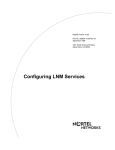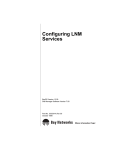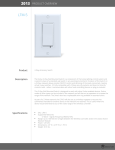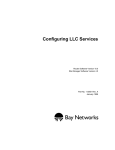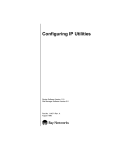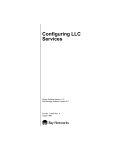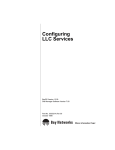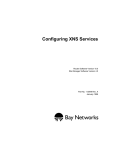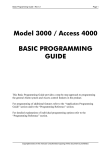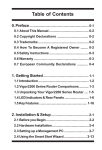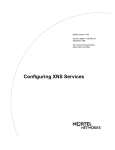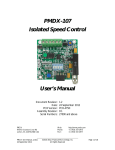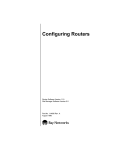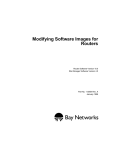Download Avaya Configuring LNM Services User's Manual
Transcript
Configuring LNM Services Router Software Version 11.0 Site Manager Software Version 5.0 Part No. 114067 Rev. A August 1996 4401 Great America Parkway Santa Clara, CA 95054 8 Federal Street Billerica, MA 01821 Copyright © 1988–1996 Bay Networks, Inc. All rights reserved. Printed in the USA. August 1996. The information in this document is subject to change without notice. The statements, configurations, technical data, and recommendations in this document are believed to be accurate and reliable, but are presented without express or implied warranty. Users must take full responsibility for their applications of any products specified in this document. The information in this document is proprietary to Bay Networks, Inc. The software described in this document is furnished under a license agreement and may only be used in accordance with the terms of that license. A summary of the Software License is included in this document. Restricted Rights Legend Use, duplication, or disclosure by the United States Government is subject to restrictions as set forth in subparagraph (c)(1)(ii) of the Rights in Technical Data and Computer Software clause at DFARS 252.227-7013. Notice for All Other Executive Agencies Notwithstanding any other license agreement that may pertain to, or accompany the delivery of, this computer software, the rights of the United States Government regarding its use, reproduction, and disclosure are as set forth in the Commercial Computer Software-Restricted Rights clause at FAR 52.227-19. Trademarks of Bay Networks, Inc. ACE, AFN, AN, BCN, BLN, BN, BNX, CN, FN, FRE, GAME, LN, Optivity, PPX, SynOptics, SynOptics Communications, Wellfleet and the Wellfleet logo are registered trademarks and ANH, ASN, Bay•SIS, BCNX, BLNX, EZ Install, EZ Internetwork, EZ LAN, PathMan, PhonePlus, Quick2Config, RouterMan, SPEX, Bay Networks, Bay Networks Press, the Bay Networks logo and the SynOptics logo are trademarks of Bay Networks, Inc. Third-Party Trademarks All other trademarks and registered trademarks are the property of their respective owners. Statement of Conditions In the interest of improving internal design, operational function, and/or reliability, Bay Networks, Inc. reserves the right to make changes to the products described in this document without notice. Bay Networks, Inc. does not assume any liability that may occur due to the use or application of the product(s) or circuit layout(s) described herein. Portions of the code in this software product are Copyright © 1988, Regents of the University of California. All rights reserved. Redistribution and use in source and binary forms of such portions are permitted, provided that the above copyright notice and this paragraph are duplicated in all such forms and that any documentation, advertising materials, and other materials related to such distribution and use acknowledge that such portions of the software were developed by the University of California, Berkeley. The name of the University may not be used to endorse or promote products derived from such portions of the software without specific prior written permission. SUCH PORTIONS OF THE SOFTWARE ARE PROVIDED “AS IS” AND WITHOUT ANY EXPRESS OR IMPLIED WARRANTIES, INCLUDING, WITHOUT LIMITATION, THE IMPLIED WARRANTIES OF MERCHANTABILITY AND FITNESS FOR A PARTICULAR PURPOSE. In addition, the program and information contained herein are licensed only pursuant to a license agreement that contains restrictions on use and disclosure (that may incorporate by reference certain limitations and notices imposed by third parties). ii 114067 Rev. A Bay Networks Software License Note: This is Bay Networks basic license document. In the absence of a software license agreement specifying varying terms, this license -- or the license included with the particular product -- shall govern licensee’s use of Bay Networks software. This Software License shall govern the licensing of all software provided to licensee by Bay Networks (“Software”). Bay Networks will provide licensee with Software in machine-readable form and related documentation (“Documentation”). The Software provided under this license is proprietary to Bay Networks and to third parties from whom Bay Networks has acquired license rights. Bay Networks will not grant any Software license whatsoever, either explicitly or implicitly, except by acceptance of an order for either Software or for a Bay Networks product (“Equipment”) that is packaged with Software. Each such license is subject to the following restrictions: 1. Upon delivery of the Software, Bay Networks grants to licensee a personal, nontransferable, nonexclusive license to use the Software with the Equipment with which or for which it was originally acquired, including use at any of licensee’s facilities to which the Equipment may be transferred, for the useful life of the Equipment unless earlier terminated by default or cancellation. Use of the Software shall be limited to such Equipment and to such facility. Software which is licensed for use on hardware not offered by Bay Networks is not subject to restricted use on any Equipment, however, unless otherwise specified on the Documentation, each licensed copy of such Software may only be installed on one hardware item at any time. 2. Licensee may use the Software with backup Equipment only if the Equipment with which or for which it was acquired is inoperative. 3. Licensee may make a single copy of the Software (but not firmware) for safekeeping (archives) or backup purposes. 4. Licensee may modify Software (but not firmware), or combine it with other software, subject to the provision that those portions of the resulting software which incorporate Software are subject to the restrictions of this license. Licensee shall not make the resulting software available for use by any third party. 5. Neither title nor ownership to Software passes to licensee. 6. Licensee shall not provide, or otherwise make available, any Software, in whole or in part, in any form, to any third party. Third parties do not include consultants, subcontractors, or agents of licensee who have licensee’s permission to use the Software at licensee’s facility, and who have agreed in writing to use the Software only in accordance with the restrictions of this license. 7. Third-party owners from whom Bay Networks has acquired license rights to software that is incorporated into Bay Networks products shall have the right to enforce the provisions of this license against licensee. 8. Licensee shall not remove or obscure any copyright, patent, trademark, trade secret, or similar intellectual property or restricted rights notice within or affixed to any Software and shall reproduce and affix such notice on any backup copy of Software or copies of software resulting from modification or combination performed by licensee as permitted by this license. 114067 Rev. A iii Bay Networks Software License (continued) 9. Licensee shall not reverse assemble, reverse compile, or in any way reverse engineer the Software. [Note: For licensees in the European Community, the Software Directive dated 14 May 1991 (as may be amended from time to time) shall apply for interoperability purposes. Licensee must notify Bay Networks in writing of any such intended examination of the Software and Bay Networks may provide review and assistance.] 10. Notwithstanding any foregoing terms to the contrary, if licensee licenses the Bay Networks product “Site Manager,” licensee may duplicate and install the Site Manager product as specified in the Documentation. This right is granted solely as necessary for use of Site Manager on hardware installed with licensee’s network. 11. This license will automatically terminate upon improper handling of Software, such as by disclosure, or Bay Networks may terminate this license by written notice to licensee if licensee fails to comply with any of the material provisions of this license and fails to cure such failure within thirty (30) days after the receipt of written notice from Bay Networks. Upon termination of this license, licensee shall discontinue all use of the Software and return the Software and Documentation, including all copies, to Bay Networks. 12. Licensee’s obligations under this license shall survive expiration or termination of this license. iv 114067 Rev. A Contents Configuring LNM Services About This Guide Before You Begin .............................................................................................................xiii Conventions .................................................................................................................... xiv Acronyms ......................................................................................................................... xv Ordering Bay Networks Publications .............................................................................. xvi Technical Support and Online Services Bay Networks Customer Service ...................................................................................xviii Bay Networks Information Services ................................................................................ xix World Wide Web ...................................................................................................... xix Customer Service FTP ............................................................................................. xix Support Source CD ................................................................................................... xx CompuServe ............................................................................................................. xx InfoFACTS ................................................................................................................ xxi How to Get Help ....................................................................................................... xxi Chapter 1 LNM Servers Overview IBM LAN Network Manager ............................................................................................1-1 Local Services ..........................................................................................................1-3 Network-Wide Services ............................................................................................1-3 LAN Management Servers .............................................................................................1-3 LAN Reporting Mechanism (LRM) ...........................................................................1-6 Reporting Link Maintenance Function ...............................................................1-6 Control Function ................................................................................................1-7 Routing Function ...............................................................................................1-8 Notification Function ..........................................................................................1-8 Security Function ...............................................................................................1-9 114067 Rev. A v Protocol Boundary Function ..............................................................................1-9 LLC Requirements .............................................................................................1-9 Ring Error Monitor (REM) ......................................................................................1-11 Hard-Error Processing Function ......................................................................1-11 Soft-Error Processing Function .......................................................................1-11 Ring Parameter Server (RPS) ................................................................................1-14 Status Request Function .................................................................................1-14 Ring Station Parameters Maintenance Function .............................................1-14 Registration Function .......................................................................................1-14 RPS Activation Function ..................................................................................1-15 Configuration Report Server (CRS) .......................................................................1-15 Station Status Request Function .....................................................................1-15 Set Station Parameters Function .....................................................................1-16 Remove Station Function ................................................................................1-16 Notification Function ........................................................................................1-16 Communication Function .................................................................................1-16 LAN Bridge Server (LBS) .......................................................................................1-16 Status Request Function .................................................................................1-17 Set Parameters Function .................................................................................1-17 Notification Function ........................................................................................1-17 Bridge Performance Monitoring Function ........................................................1-17 For More Information about the LAN Management Servers .........................................1-17 Chapter 2 LNM Servers Implementation Notes Initial Configuration .........................................................................................................2-1 Site Manager ............................................................................................................2-1 IBM LAN Network Manager .....................................................................................2-2 Internal MAC Address .......................................................................................2-3 External MAC Address ......................................................................................2-4 Using IBM LAN Net Manager to Set LNM Parameters ......................................2-5 Number of RPS Servers per Ring ..................................................................................2-6 Redundant Servers on a Ring ........................................................................................2-6 Passwords ......................................................................................................................2-6 vi 114067 Rev. A Chapter 3 Enabling LNM Servers Enabling LNM Servers on an Interface ...........................................................................3-1 Chapter 4 Editing LNM Servers Parameters Accessing LNM Servers Parameters ..............................................................................4-2 Editing LNM Servers Global Parameters ........................................................................4-3 Editing LNM Servers Interface Parameters ....................................................................4-5 Deleting LNM Servers from a Circuit ............................................................................4-12 Deleting the LNM Servers from the Bay Networks Node ..............................................4-12 Appendix A Site Manager Default Settings Index 114067 Rev. A vii Figures Figure 1-1. Figure 1-2. Figure 1-3. Figure 2-1. Figure 4-1. Figure 4-2. Figure 4-3. Figure 4-4. 114067 Rev. A The LNM Servers .....................................................................................1-5 Controlling and Observing LAN Network Managers ................................1-8 Reporting Links via Multiplexed LLC2 Sessions ....................................1-10 Source Routing, LNM, and Line Parameters ...........................................2-3 Configuration Manager Window ...............................................................4-2 Edit LNM Global Parameters Window ......................................................4-3 LNM Interface Configuration Window ......................................................4-5 LNM Interface Configuration Window (Scrolled) ......................................4-6 ix Tables Table 1-1. Table A-1. Table A-2. 114067 Rev. A MAC Sublayer Servers and Their Functional Addresses .........................1-4 LNM Global Parameters .......................................................................... A-1 LNM Servers Interface Parameters ......................................................... A-1 xi About This Guide If you are responsible for configuring and managing Bay Networks routers, read this guide to learn how to customize router software for LNM services. The LNM Servers are the Bay Networks implementation of the five LAN management servers described in the IBM Token Ring Architecture Reference. Configuring LNM Services offers • An overview of the LNM routing protocol and a description of how Bay Networks routing servers work (Chapter 1) • Implementation notes that may affect how you configure LNM Servers (Chapter 2) • Instructions on enabling LNM Servers (Chapter 3) • Instructions on editing LNM global and interface parameters and configuring LNM Servers (Chapter 4) Before You Begin Before using this guide, you must complete the following procedures: • Create and save a configuration file that has at least one set of LNM Servers and a Source Routing Bridge interface. • Retrieve the configuration file in local, remote, or dynamic mode. Refer to Configuring Routers for instructions. 114067 Rev. A xiii Configuring LNM Services Conventions angle brackets (< >) Indicate that you choose the text to enter based on the description inside the brackets. Do not type the brackets when entering the command. Example: if command syntax is ping <ip_address>, you enter ping 192.32.10.12 bold text Indicates text that you need to enter, command names, and buttons in menu paths. Example: Enter wfsm & Example: Use the dinfo command. Example: ATM DXI > Interfaces > PVCs identifies the PVCs button in the window that appears when you select the Interfaces option from the ATM DXI menu. brackets ([ ]) Indicate optional elements. You can choose none, one, or all of the options. italic text Indicates variable values in command syntax descriptions, new terms, file and directory names, and book titles. quotation marks (“ ”) Indicate the title of a chapter or section within a book. screen text Indicates data that appears on the screen. Example: Set Bay Networks Trap Monitor Filters separator ( > ) Separates menu and option names in instructions and internal pin-to-pin wire connections. Example: Protocols > AppleTalk identifies the AppleTalk option in the Protocols menu. Example: Pin 7 > 19 > 20 vertical line (|) Indicates that you enter only one of the parts of the command. The vertical line separates choices. Do not type the vertical line when entering the command. Example: If the command syntax is show at routes | nets, you enter either show at routes or show at nets, but not both. xiv 114067 Rev. A About This Guide Acronyms ANSI ARP ATM CMIP EGP FDDI IEEE ILI IS-IS LNM MAC MOP OSI OSPF PVCs QENET RIP SMDS SNAP SNMP SRM SVCs TCP/IP TFTP 114067 Rev. A American National Standards Institute Address Resolution Protocol Asynchronous Transfer Mode Common Management Information Protocol Exterior Gateway Protocol Fiber Distributed Data Interface Institute of Electrical and Electronic Engineers intelligent link interface Intermediate System to Intermediate System LAN network manager media access control Maintenance Operations Protocol Open Systems Interconnection Open Shortest Path First permanent virtual circuits Quad Ethernet Link Module Routing Information Protocol Switched Multimegabit Data Services Subnetwork Access Protocol Simple Network Management Protocol system resource modules switched virtual circuits Transmission Control Protocol/Internet Protocol Trivial File Transfer Protocol xv Configuring LNM Services Ordering Bay Networks Publications To purchase additional copies of this document or other Bay Networks publications, order by part number from the Bay Networks Press™ at the following telephone or fax numbers: • Telephone - U.S./Canada • Telephone - International • Fax 1-888-4BAYPRESS 1-510-490-4752 1-510-498-2609 You can also use these numbers to request a free catalog of Bay Networks Press product publications. xvi 114067 Rev. A Technical Support and Online Services To ensure comprehensive network support to our customers and partners worldwide, Bay Networks Customer Service has Technical Response Centers in key locations around the globe: • • • • • Billerica, Massachusetts Santa Clara, California Sydney, Australia Tokyo, Japan Valbonne, France The Technical Response Centers are connected via a redundant Frame Relay Network to a Common Problem Resolution system, enabling them to transmit and share information, and to provide live, around-the-clock support 365 days a year. Bay Networks Information Services complement the Bay Networks Service program portfolio by giving customers and partners access to the most current technical and support information through a choice of access/retrieval means. These include the World Wide Web, CompuServe, Support Source CD, Customer Support FTP, and InfoFACTS document fax service. 114067 Rev. A xvii Configuring LNM Services Bay Networks Customer Service If you purchased your Bay Networks product from a distributor or authorized reseller, contact that distributor’s or reseller’s technical support staff for assistance with installation, configuration, troubleshooting, or integration issues. Customers can also purchase direct support from Bay Networks through a variety of service programs. As part of our PhonePlus™ program, Bay Networks Service sets the industry standard, with 24-hour, 7-days-a-week telephone support available worldwide at no extra cost. Our complete range of contract and noncontract services also includes equipment staging and integration, installation support, on-site services, and replacement parts delivery -- within approximately 4 hours. To purchase any of the Bay Networks support programs, or if you have questions on program features, use the following numbers: Region Telephone Number Fax Number United States and Canada 1-800-2LANWAN; enter Express Routing Code (ERC) 290 when prompted (508) 670-8766 (508) 436-8880 (direct) Europe (33) 92-968-300 (33) 92-968-301 Asia/Pacific Region (612) 9927-8800 (612) 9927-8811 Latin America (407) 997-1713 (407) 997-1714 In addition, you can receive information on support programs from your local Bay Networks field sales office, or purchase Bay Networks support directly from your authorized partner. xviii 114067 Rev. A Technical Support and Online Services Bay Networks Information Services Bay Networks Information Services provide up-to-date support information as a first-line resource for network administration, expansion, and maintenance. This information is available from a variety of sources. World Wide Web The Bay Networks Customer Support Web Server offers a diverse library of technical documents, software agents, and other important technical information to Bay Networks customers and partners. A special benefit for contracted customers and resellers is the ability to access the Web Server to perform Case Management. This feature enables your support staff to interact directly with the network experts in our worldwide Technical Response Centers. A registered contact with a valid Site ID can • View a listing of support cases and determine the current status of any open case. Case history data includes severity designation, and telephone, e-mail, or other logs associated with the case. • Customize the listing of cases according to a variety of criteria, including date, severity, status, and case ID. • Log notes to existing open cases. • Create new cases for rapid, efficient handling of noncritical network situations. • Communicate directly via e-mail with the specific technical resources assigned to your case. The Bay Networks URL is http://www.baynetworks.com. Customer Service is a menu item on that home page. Customer Service FTP Accessible via URL ftp://support.baynetworks.com (134.177.3.26), this site combines and organizes support files and documentation from across the Bay Networks product suite, including switching products from our Centillion™ and Xylogics® business units. Central management and sponsorship of this FTP site lets you quickly locate information on any of your Bay Networks products. 114067 Rev. A xix Configuring LNM Services Support Source CD This CD-ROM -- sent quarterly to all contracted customers -- is a complete Bay Networks Service troubleshooting knowledge database with an intelligent text search engine. The Support Source CD contains extracts from our problem-tracking database; information from the Bay Networks Forum on CompuServe; comprehensive technical documentation, such as Customer Support Bulletins, Release Notes, software patches and fixes; and complete information on all Bay Networks Service programs. You can run a single version on Macintosh Windows 3.1, Windows 95, Windows NT, DOS, or UNIX computing platforms. A Web links feature enables you to go directly from the CD to various Bay Networks Web pages. CompuServe For assistance with noncritical network support issues, Bay Networks Information Services maintain an active forum on CompuServe, a global bulletin-board system. This forum provides file services, technology conferences, and a message section to get assistance from other users. The message section is monitored by Bay Networks engineers, who provide assistance wherever possible. Customers and resellers holding Bay Networks service contracts also have access to special libraries for advanced levels of support documentation and software. To take advantage of CompuServe’s recently enhanced menu options, the Bay Networks Forum has been re-engineered to allow links to our Web sites and FTP sites. We recommend the use of CompuServe Information Manager software to access these Bay Networks Information Services resources. To open an account and receive a local dial-up number in the United States, call CompuServe at 1-800-524-3388. Outside the United States, call 1-614-529-1349, or your nearest CompuServe office. Ask for Representative No. 591. When you are on line with your CompuServe account, you can reach us with the command GO BAYNET. xx 114067 Rev. A Technical Support and Online Services InfoFACTS InfoFACTS is the Bay Networks free 24-hour fax-on-demand service. This automated system has libraries of technical and product documents designed to help you manage and troubleshoot your Bay Networks products. The system responds to a fax from the caller or to a third party within minutes of being accessed. To use InfoFACTS in the United States or Canada, call toll-free 1-800-786-3228. Outside North America, toll calls can be made to 1-408-764-1002. In Europe, toll-free numbers are also available for contacting both InfoFACTS and CompuServe. Please check our Web page for the listing in your country. How to Get Help Use the following numbers to reach your Bay Networks Technical Response Center: 114067 Rev. A Technical Response Center Telephone Number Fax Number Billerica, MA 1-800-2LANWAN (508) 670-8765 Santa Clara, CA 1-800-2LANWAN (408) 764-1188 Valbonne, France (33) 92-968-968 (33) 92-966-998 Sydney, Australia (612) 9927-8800 (612) 9927-8811 Tokyo, Japan (81) 3-5402-0180 (81) 3-5402-0173 xxi Chapter 1 LNM Servers Overview LNM Services are embodied in the LNM Servers program, the Bay Networks implementation of the five LAN management servers described in the IBM Token Ring Architecture Reference. The LNM Servers provide a means for an IBM LAN Network Manager application to monitor and control stations attached to a locally attached token-ring LAN. Note: Bay Networks system software does not support the use of IBM LAN Network Manager to manage or monitor 802.3/Ethernet LAN segments or adapters through a Source-Routing-Translating Bridge. This chapter provides • A brief overview of the IBM LAN Network Manager (LNM) application program • An overview of the Bay Networks LNM Servers • A list of additional technical resources IBM LAN Network Manager IBM LAN Network Manager is a PC application that allows a network administrator to manage multisegment 802.5/token-ring networks. The administrator of a building or campus network can use IBM LAN Network Manager to monitor a single LAN or a group of LANs. 114067 Rev. A 1-1 Configuring LNM Services IBM LAN Network Manager can also communicate with the IBM NetView host-based network management product. This enables a NetView administrator to gain access to certain operating capabilities of the IBM LAN Network Manager application. IBM LAN Network Manager provides facilities for managing the media and adapters within a LAN, and for managing source-routing bridges that interconnect LAN segments. When using an IBM LAN Network Manager workstation, a network administrator can • Display alerts and recommended actions • Generate event log reports • Query, remove, or monitor adapters within the network • Establish a communications link with an IBM bridge for the purposes of LAN management • Query and configure IBM bridges • Monitor token-ring network status and errors • Perform token-ring path tests and LAN segment tests When accessing IBM LAN Network Manager via IBM NetView, a network administrator can • Display IBM LAN Network Manager alerts and recommended actions • Generate IBM LAN Network Manager event log reports • Issue commands to IBM LAN Network Manager Within a token-ring LAN environment, IBM LAN Network Manager can access two different levels of management: • Local services • Network-wide services These services are provided by LNM Servers; see “LNM Management Servers” later in this chapter for a discussion of servers. 1-2 114067 Rev. A LNM Servers Overview Local Services Local services provided by LNM Servers enable you to control each station attached to a token-ring segment. Some examples of local services provided by LNM Servers are • • • Initializing new stations with the same parameters used to initialize all other stations attached to the same ring Noting the address of the Next Active Upstream Neighbor for each station on a ring Collecting error detection messages placed on a specified ring by stations already attached to the same ring Network-Wide Services Network-wide services provided by LNM Servers enable you to configure and monitor, from a central site, the operation of each segment of a token-ring LAN. Some examples of network-wide services are • • • • Requesting statistics or configuration information from LNM Servers Removing a ring station from a designated ring Collecting error information on the operation of a designated ring Permitting manual intervention where necessary to resolve certain operational problems existing on a designated ring LAN Management Servers The IBM Token Ring Architecture Reference defines five servers that provide local, network-wide, or both types of services to the IBM LAN Network Manager application. The servers are • • • • • 114067 Rev. A LAN Reporting Mechanism (LRM) Ring Error Monitor (REM) Ring Parameter Server (RPS) Configuration Report Server (CRS) LAN Bridge Server (LBS) 1-3 Configuring LNM Services REM, RPS, and CRS are MAC sublayer servers, and each has its own functional address on the physical LAN it helps to observe or control (Table 1-1). Table 1-1. MAC Sublayer Servers and Their Functional Addresses MAC Sublayer Server Functional Address REM C00000000008 RPS C00000000002 CRS C00000000002 LRM and LBS are not MAC sublayer servers, and hence have no MAC functional address. LRM and LBS are addressed by means of LLC2 sessions and a protocol internal to the LNM Servers interface. Ring stations send frames onto the ring to report various conditions. These are MAC frames, and are sent to a particular functional address. The functional addresses of the management servers REM, RPS, and CRS are reserved by IBM for this purpose. For more information on functional addresses, refer to the IBM Token Ring Network Architecture Reference. Figure 1-1 shows the five servers as LLC and MAC sublayer components configured on a token-ring circuit. The servers are configured on the same circuit as the source-routing bridge interface for the locally attached ring. 1-4 114067 Rev. A LNM Servers Overview LLC Sublayer LLC2 LLC2 Frames LRM MAC Sublayer LBS Internal Protocol REM RPS MAC Frames CRS MAC Frames Physical Layer 802.5/Token Ring LAN LNM0001A Figure 1-1. The LNM Servers The following sections provide an overview of the five management servers. 114067 Rev. A 1-5 Configuring LNM Services LAN Reporting Mechanism (LRM) The Bay Networks implementation of LRM is one of five LAN management servers you configure on a token-ring circuit. LRM supplies network-wide services to the IBM LAN Network Manager application. (The services do not extend beyond the topology of the local token ring.) To supply these services, LRM manages all communications between the IBM LAN Network Manager application and the other management servers. LRM supports the following major functions: • Reporting Link Maintenance Function • Control Function • Routing Function • Notification Function • Security Function • Protocol Boundary Function Reporting Link Maintenance Function The LRM Reporting Link Maintenance Function maintains a separate LLC2 connection (called a reporting link) to each IBM LAN Network Manager workstation. Other management servers (REM, RPS, CRS, and LBS) use the reporting links managed by LRM to communicate with the IBM LAN Network Manager, rather than having each server manage its own independent links with the IBM LAN Network Manager workstation. If a Bay Networks router becomes the only station on a token ring segment, the router removes and reinserts itself on the ring. As a result: • Any reporting link established between a remote IBM LAN Network Manager and the LNM Servers on that segment fails. • The IBM LAN Network Manager Events Log receives an alert message indicating the failure of the reporting link. If you want to ensure that the IBM LAN Network Manager maintains a reporting link to the LNM Servers on the local Bay Networks bridge, you can enable autolinking on the IBM LAN Network Manager. It can then reopen the failed reporting link when the Bay Networks LNM Servers interface becomes active on the ring. 1-6 114067 Rev. A LNM Servers Overview You can also set the “Auto-link time interval” in the IBM LAN Network Manager System Parameters to a value that achieves the best balance between the amount of time in which you require access to the Bay Networks LNM Servers on the desired segment and the potential traffic generated by periodic attempts to reestablish the failed reporting link. You can also disable autolinking on an unnecessary reporting link. Control Function The LRM Control Function allows the LAN reporting mechanism to define • One IBM LAN Network Manager as the controlling manager • One or more IBM LAN Network Managers as noncontrolling or observing IBM LAN Network Managers LRM maintains communication between its local management servers and all authorized IBM LAN Network Manager entities. (The LNM Servers include authorization password functionality, described later in this chapter.) Figure 1-2 shows one LRM server reporting to multiple IBM LAN Network Manager clients, with only one client controlling the functions and actions of the management servers. Figure 1-2 also shows three Observing LAN Network Managers, which are described later in this chapter. 114067 Rev. A 1-7 Configuring LNM Services LLC2 Reporting Links Controlling LAN Network Manager LLC2 Frames LRM LBS Observing LAN Network Manager Internal Protocol Observing LAN Network Manager REM CRS MAC Frames Observing LAN Network Manager MAC Frames Physical Layer Key = LNM Servers LNM0002A Figure 1-2. Controlling and Observing LAN Network Managers Routing Function The LRM Routing Function forwards frames from an IBM LAN Network Manager to the appropriate management server (REM, RPS, CRS, or LBS). The routing function also forwards responses and unsolicited notifications from the management servers to selected remote IBM LAN Network Manager applications. Notification Function The LRM Notification Function notifies an IBM LAN Network Manager when requests for new reporting links are accepted or rejected. 1-8 114067 Rev. A LNM Servers Overview Security Function The LRM Security Function maintains and checks ASCII passwords that are used to authenticate users of reporting links. Protocol Boundary Function The LRM Protocol Boundary Function allows communication between LRM and its associated management servers. The protocol boundary function also provides a means for management servers to inform LRM about their state (active or inactive). LLC Requirements To provide enterprise-wide services for the IBM LAN Network Manager application, LRM requires the presence of an LLC2 sublayer on the same source-routing bridge. LLC2 services are necessary to support reporting links to the IBM LAN Network Manager application (Figure 1-3). 114067 Rev. A 1-9 Configuring LNM Services Net Management Station (PC) Ring Station (e.g., a PC) LAN Network Manager Bay Networks Router Bay Networks Router Source Routing LLC Session A LLC MAC LLC Session B PHYS LLC Session C LLC2 LLC LLC2 LLC LLC2 LLC LLC2 LLC LLC2 MAC MAC MAC MAC MAC PHYS PHYS PHYS PHYS PHYS TR LAN 1 Note: Source Routing TR LAN 2 TR LAN 3 LLC Session A communicates information about TR LAN 2. LLC Sessions B and C communiate information about TR LAN 3. Network Management Station collects information about TR LAN 1, 2, and 3. LNM0003A Figure 1-3. Reporting Links via Multiplexed LLC2 Sessions Note: For more information on LLC support for the LNM Servers, refer to Configuring LLC Services. You initially establish the reporting link through the “Bridge Link” function of the IBM LAN Network Manager application software. (For more information on how to use the Bridge Link function, refer to the IBM LAN Network Manager User’s Guide.) 1-10 114067 Rev. A LNM Servers Overview Ring Error Monitor (REM) The Bay Networks implementation of REM is one of five LAN management servers you configure on a token-ring circuit. REM observes, collects, and analyzes hard-error and soft-error reports sent by ring stations on a single ring, and assists in fault isolation and correction. The REM functional address on the ring is the destination address for all soft-error reports generated by ring stations. Hard-error reports are sent to the all-stations MAC address and examined by the REM hard-error analysis program. REM supports the following functions: • Hard-Error Processing Function • Soft-Error Processing Function Hard-Error Processing Function The REM Hard-Error Processing Function detects and reports hard errors. Hard errors are permanent or temporary faults, usually in equipment attached to a ring. Permanent hard errors cannot be corrected by software; temporary hard errors can be corrected by software. Hard errors typically cause a ring to cease operating. A ring station downstream from the faulty station recognizes a hard error, and transmits Beacon MAC frames at specified intervals, until the faulty station removes itself from the affected ring. Soft-Error Processing Function The REM Soft-Error Processing Function determines whether a nonrandom or excessive soft-error condition is occurring on the ring to which REM is attached. If possible, REM isolates the most probable source of the soft errors to a single fault domain, where fault domain consists of a ring station, its Next Active Upstream Neighbor, and the media between them. The REM Soft-Error Processing Function includes the following additional functions: 114067 Rev. A • Soft-Error Reporting Function • Nonisolating Soft-Error Processing Function • Isolating Soft-Error Processing Function • Intensive Mode Reporting Function 1-11 Configuring LNM Services • Receiver-Congestion Error Reporting Function • Status Request Function • Set Parameters Function Soft-Error Reporting Function REM performs error detection and isolation by analyzing soft-error MAC frames that are periodically sent by ring stations experiencing errors. These MAC frames are sent to the functional address assigned to REM. REM analyzes the soft-error frames as they arrive and determines whether soft errors are occurring at a rate that potentially or currently degrades the performance of the ring. When REM detects such a condition, it notifies the IBM LAN Network Manager and, when possible, provides data indicating the probable source of the error. The error counters included in a soft-error MAC frame sent by a station are divided into two types: isolating and nonisolating, which correspond to the type of error being reported. The source of an isolating error can be isolated to a fault domain; the source of a nonisolating error cannot be isolated to a domain smaller than the ring. Nonisolating Soft-Error Processing Function Nonisolating errors can be isolated only to the ring on which they occur. A counter is kept for each type of nonisolating error that is reported to REM in soft-error MAC frames. Some internal error counters are also treated as nonisolating errors. If one of these counters exceeds a threshold value, a notification is sent (through LRM) to the IBM LAN Network Manager application, and the REM soft-error counter is reset. No other analysis is performed by REM for nonisolating errors. Isolating Soft-Error Processing Function When REM receives a soft-error MAC frame, the accumulated isolating error count is interpreted as a weight. The weight associated with a particular station indicates the likelihood that station is causing excessive soft errors on the local ring. REM stores information on stations having nonzero weights in a table. REM watches for an excessive-soft-error threshold in the table. Exceeding the threshold indicates that • 1-12 A problem exists on the local ring 114067 Rev. A LNM Servers Overview • Ring performance is eroding as a result of this problem Exceeding the threshold causes REM to notify the IBM LAN Network Manager of the error/ring-performance condition. The notification appears as a Weight Threshold event that you can view and interpret with the Bay Networks Events Manager tool. Once you have determined the typical (noncritical or tolerable) error characteristics of the local ring, you can set a value for the Error Rate Threshold, which is an LNM interface parameter. The threshold you set provides for adequate warning of legitimate (performance-degrading) problems on the locally attached ring. (Until you make this determination, you can use the default Error Rate Threshold setting provided by the Bay Networks LNM Servers software.) For information on how to access and edit the Error Rate Threshold parameter, refer to Chapter 4. Intensive Mode Reporting Function The REM Intensive Mode Reporting Function is a facility that enables an IBM LAN Network Manager to request a Ring Error Monitor to forward selected soft-error MAC frames. The requesting IBM LAN Network Manager receives the requested frames. Receiver-Congestion Error Reporting Function The REM Receiver-Congestion Error Reporting Function identifies stations that cannot receive a significant number of frames from the ring because their input buffers are full. Status Request Function The REM Status Request Function accepts and responds to requests for status from IBM LAN Network Manager. Set Parameters Function The REM Set Parameters Function accepts and executes requests from the controlling IBM LAN Network Manager to set REM’s parameters. 114067 Rev. A 1-13 Configuring LNM Services Ring Parameter Server (RPS) The Bay Networks implementation of RPS is one of five LAN management servers you configure on a token-ring circuit. RPS provides the following main services: • Sends initialization information to new stations that are attaching to the ring • Ensures that stations on the ring have consistent values for operating parameters • Forwards registration information from stations attaching to the ring to the IBM LAN Network Manager application RPS also supports the following functions: • Status Request Function • Ring Station Parameters Maintenance Function • Registration Function • RPS Activation Function Status Request Function The RPS Status Request Function accepts and executes requests for status from the IBM LAN Network Manager application. Ring Station Parameters Maintenance Function The RPS Ring Station Parameters Maintenance Function issues commands to set parameter values in ring stations. The ring station operational parameters controlled by RPS are • Ring number • Soft-error report timer Registration Function The RPS Registration Function accepts unsolicited registration information from ring stations and forwards this information to the IBM LAN Network Manager application through LRM. RPS also responds to the station’s request for registration by sending the current values for the ring’s operational parameters to the requesting station. 1-14 114067 Rev. A LNM Servers Overview RPS Activation Function When a Ring Parameter Server becomes active on a ring, it determines if another RPS is already active on the ring. If another RPS is not active on the same ring, the RPS in the attaching station activates its Ring Station Parameters Maintenance Function. It then broadcasts an Initialize Ring Station MAC frame a predetermined number of times to all stations on the same ring. This mechanism facilitates the establishment of default ring operational parameters. If another RPS is already active on the same ring, the new RPS compares the values received for the ring’s operational parameters with its own stored values. If the values match, the RPS activates its RPS function. If the values do not match, the new RPS reports that its parameters are inconsistent with the existing parameters for the ring. The RPS then disables its own functional address, to prevent it from receiving requests for initialization from stations attaching to the ring. Configuration Report Server (CRS) The Bay Networks implementation of CRS is one of five LAN management servers you configure on a token-ring circuit. CRS accepts commands from the IBM LAN Network Manager application to get station information, set station parameters, and remove stations on the locally attached ring. CRS also collects and forwards configuration reports generated by stations on the local ring to the IBM LAN Network Manager application. CRS supports the following functions: • Station Status Request Function • Set Station Parameters Function • Remove Station Function • Notification Function • Communication Function Station Status Request Function The CRS Station Status Request Function accepts and executes requests from the IBM LAN Network Manager application to get the status of stations on CRS’s ring and returns the results to the IBM LAN Network Manager application through LRM. 114067 Rev. A 1-15 Configuring LNM Services Set Station Parameters Function The CRS Set Station Parameters Function accepts and executes requests from the IBM LAN Network Manager application to set the values of operational parameters in stations on CRS’s ring. The success or failure of this operation is reported to the IBM LAN Network Manager application through LRM. Remove Station Function The CRS Remove Station Function accepts and executes requests from the IBM LAN Network Manager application to force a station to leave CRS’s ring. The success or failure of this operation is reported to the IBM LAN Network Manager application through LRM. Notification Function The CRS Notification Function forwards information about configuration changes on CRS’s ring to the IBM LAN Network Manager application through LRM. The configuration changes reported are new Active Monitor and new Next Active Upstream Neighbor. Communication Function The CRS Communication Function determines the types of frames sent between CRS and the IBM LAN Network Manager application, using the LRM reporting link. LAN Bridge Server (LBS) The Bay Networks implementation of LBS is one of five LAN management servers you configure on a token-ring circuit. LBS keeps statistical information about frames forwarded between two rings (through a source-routing bridge) and sends this information to selected IBM LAN Network Managers (through LRM). LBS supports the following functions: 1-16 • Status Request Function • Set Parameters Function • Notification Function • Bridge Performance Monitoring Function 114067 Rev. A LNM Servers Overview Status Request Function The LBS Status Request Function accepts and responds to requests for status from the IBM LAN Network Manager application. Set Parameters Function The LBS Set Parameters Function accepts and executes commands from a controlling IBM LAN Network Manager. The commands change the operational parameters of LBS. Notification Function The LBS Notification Function collects inter-ring traffic statistics and forwards this information to the IBM LAN Network Manager application. This function also notifies IBM LAN Network Manager of LBS state changes. Bridge Performance Monitoring Function The LBS Bridge Performance Monitoring Function maintains counters for • The number of frames and bytes forwarded through the bridge • The number of frames not received by a bridge station because the station was congested Periodically the percentage of frames lost or discarded by the bridge because of anomalies is calculated and, if the percentage exceeds a predefined threshold, LBS sends a notification to the IBM LAN Network Manager application. LBS can also be configured to periodically send its error and traffic counters to the IBM LAN Network Manager application to allow for trend analysis by the application. For More Information about the LAN Management Servers The following publications provide technical detail on Token Ring LANs, Source Routing Bridges, the IBM LAN Network Manager application, and the LAN Network Management Servers LRM, REM, RPS, CRS, and LBS: IBM Corporation, SC303374-2. IBM Token Ring Network Architecture Reference. Third Edition. September 1989. 114067 Rev. A 1-17 Configuring LNM Services IBM Corporation, 31G6962. IBM LAN Network Manager User’s Guide. December 1991. IBM Corporation, SA21-9994-0. IBM 8209 Local Area Network Bridge. IBM Corporation, 31G6960. IBM Token Ring Network Bridge Program Version 2.2 User’s Guide. Fifth Edition. 1990. Perlman, Radia. Interconnections: Bridges and Routers. Reading, MA. Addison-Wesley Publishing Company. May 1992. 1-18 114067 Rev. A Chapter 2 LNM Servers Implementation Notes This chapter provides basic guidelines for configuring and using the Bay Networks LNM Servers, and for using IBM LAN Network Manager versus the Site Manager for LNM Server operations. Initial Configuration When you configure the LNM Servers on a Bay Networks router, both Site Manager and IBM LAN Network Manager require specific configuration information, as described in this chapter. Site Manager When you select the LNM Servers in the Protocols selection window, the Configuration Manager tool automatically selects Source Routing and LLC2. You must supply the following information to Site Manager through the Configuration Manager tool: 114067 Rev. A • Source Routing global parameters (Internal LAN ID, Bridge ID, Group LAN ID) • Source Routing interface parameters (Ring Number) • LNM Servers interface parameters (refer to “Internal MAC Address”) • Line parameters (refer to “External MAC Address”) 2-1 Configuring LNM Services Refer to the following sources for information on how to access and edit these parameters: • Chapter 4 (for Internal MAC Address, an LNM Servers interface parameter) • Configuring Bridging Services (for Source Routing Bridge global and interface parameters) • Configuring Routers (for the MAC address specified as a Circuit/Line-Detail parameter) IBM LAN Network Manager To acquire knowledge of LNM Servers on a Bay Networks router, the IBM LAN Network Manager program requires you to • Define source-routing bridges in your network. (You supply the MAC address on each side of any source-routing bridge configured with LAN management servers.) • Link to source-routing bridges in your network. (You use the Bridge Linking function of the IBM LAN Network Manager program.) Each MAC address must be unique within the associated source-routing network. The two MAC addresses you need to supply to IBM LAN Network Manager are called • Internal MAC Address (associated with the Internal LAN of the router) • External MAC Address (associated with the token-ring circuit you wish to monitor or control by means of IBM LAN Network Manager workstations) Figure 2-1 shows a Bay Networks router configured with several Source Routing Bridge interfaces, each of which supports a set of LNM Servers. Each set of Servers in turn monitors activity on a locally attached token ring segment. The diagram shows the locations logically associated with the Internal and External MAC addresses required by an IBM LAN Network Manager workstation for each LNM-capable bridge on a router. The diagram also shows the locations logically associated with the Internal LAN ID and the external Ring IDs. 2-2 114067 Rev. A LNM Servers Implementation Notes Token Ring IBM LAN Network Manager Workstation (Ring ID) (External MAC) Bay Networks Router (Internal MAC) SR Bridge w/ Servers Bridge (Internal Internal LAN MAC) SR Bridge w/ Servers (External MAC) Token Ring Token Ring (Internal LAN ID) SR Bridge (Internal MAC) w/ Servers (External MAC) (Ring ID) Note: IBM LAN Network Manager displays the ID of the Bay Networks Internal LAN as a segment of its Segment List. The IBM LAN Network Manager 1.1 graphical representation of your network does not display source routing bridges not defined with associated Bay Networks LNM Servers. Token Ring (Ring ID) LNM0004A Figure 2-1. Source Routing, LNM, and Line Parameters Internal MAC Address Internal MAC Address is an LNM Servers interface-level parameter. You must enter an internal MAC address when you initially add an LNM Servers interface to the router configuration. 114067 Rev. A 2-3 Configuring LNM Services The only requirement for the Internal MAC Address parameter is that its value always be unique within the associated source-routing network. For information on how to access or edit this parameter, refer to Chapter 4, “Editing LNM Servers Parameters.” External MAC Address Each circuit on which you need to configure an LNM Servers interface has an associated MAC address on the locally attached token-ring segment. You set this address by means of the MAC Address Select parameter of the circuit associated with that segment. You can access the MAC Address Select parameter by means of the following procedure: 1. Select Circuits > Edit Circuit from the Configuration Manager window. (This invokes the Circuits List window.) 2. In the Circuits List window, click on the name of a circuit on which you want to configure an LNM Servers interface. 3. Click on Edit in the Circuits List window. (This invokes the Circuit Definition window.) 4. From the Circuit Definition window, select Lines > Edit Line to access the MAC Address Select parameter. The MAC Address Select parameter allows three options: • BOXWIDE • PROM (Default setting) • CNFG Caution: Do not use the BOXWIDE option of the MAC Address Select parameter associated with any circuit on which you wish to configure an LNM Servers interface. If you do, the IBM LAN Network Manager application is unable to differentiate between LNM Servers on different circuits of a Bay Networks router. 2-4 114067 Rev. A LNM Servers Implementation Notes If you use the PROM-based MAC address option (the default) for a given circuit, you must subsequently use the Quick Get function of the Statistics Manager tool to discover the actual address written into the LNM interface record for that circuit. (For information on how to use the Quick Get tool, refer to Managing Routers and BNX Platforms.) Once you obtain the address supplied by the PROM associated with that circuit, you can enter the value into the appropriate parameter field of the IBM LAN Network Manager application. If you choose the CNFG (user-configured) option, you must also enter a unique value into the MAC Address Override parameter field associated with that circuit. As with the PROM-based option, the address you enter into the MAC Address Override parameter field must be unique within the associated source-routing network. Using IBM LAN Net Manager to Set LNM Parameters Bay Networks router software does not allow the Controlling IBM LAN Network Manager application to set MIB values on a Bay Networks router. The LNM “Set” Privilege global parameter has a default setting of Disable for this reason. Site Manager allows you to change the setting of this parameter to Enable, but you must use only the default Disable setting. If you attempt to use IBM LAN Network Manager to set the value of a parameter in the MIB, you receive an error message such as the following one from LAN Network Manager: Bridge parameters could not be set for the listed reason (n) eporting Link 0-8 DFIPD456E In this example, the Reporting Link number is 0, and the Reason Code is 8, which means that the Bay Networks router rejected the SET operation. For more information on messages of this type, refer to the IBM LAN Network Manager User’s Guide. 114067 Rev. A 2-5 Configuring LNM Services Number of RPS Servers per Ring The IBM Token Ring Network Architectural Reference specifies that only one RPS server should exist on each token-ring segment. You must ensure that among all Bay Networks bridges and other bridges on a given segment, only one RPS server is enabled. Redundant Servers on a Ring The IBM LAN Network Manager workstation might have its own set of management servers monitoring the segment locally attached to that workstation. Refer to Figure 2-1. If this is true, then you need not enable the LNM Servers on the Bay Networks source-routing bridge interface to the same segment. Passwords Bay Networks system software includes ASCII password functionality for the Controlling and Observing IBM LAN Network Manager applications. You can use the password parameters of the LNM Servers Interfaces screen to support password-only access for up to four (authorized) Reporting Links to the LRM Server for a given bridge. (LRM can communicate with the Controlling IBM LAN Network Manager and up to three Observing IBM LAN Network Managers.) This capability is defined as a Security Function in the IBM Token Ring Network Architectural Reference. This Security Function maintains and checks passwords that are used to authenticate users of Reporting Links, usually network administrators who are using the IBM LAN Network Manager application. The designated Controlling and Observing IBM LAN Network Manager applications automatically receive notification when LRM in a given sourcerouting bridge rejects an attempt by an unauthorized IBM LAN Network Manager to establish a Reporting Link to that LRM server. 2-6 114067 Rev. A Chapter 3 Enabling LNM Servers This chapter describes how to enable LNM Servers. It assumes you have 1. Opened a configuration file. 2. Specified router hardware if this is a local-mode configuration file. 3. Selected the link or net module connector on which you are enabling LNM. Enabling LNM Servers on an Interface To enable LNM Servers on an interface, complete the following steps: 1. Select LNM from the WAN Protocols menu; this menu appears after you select a link or net module connector that requires a WAN circuit. Protocol prioritization is enabled automatically when you select LNM. For detailed information on protocol prioritization, refer to Configuring Traffic Filters and Protocol Prioritization. 2. Click on OK to enable default LNM Servers. The Configuration Manager displays the Select Protocols window. Go to the appropriate protocol-specific guide for information on enabling the protocols you want to run on this interface. When you enable LNM Servers, you do not have to configure any LNM parameters. The Configuration Manager supplies default values for all LNM parameters. If you want to edit these default values, refer to Chapter 4. 114067 Rev. A 3-1 Chapter 4 Editing LNM Servers Parameters This chapter describes how you use Site Manager software to • Access LNM Servers parameters • Edit LNM Servers global parameters • Edit LNM Servers interface parameters • Delete LNM Servers from a circuit • Delete all LNM Servers from the router Once you successfully enable a set of LNM Servers on the router, you can use Site Manager to edit parameters associated with the servers. Note that you can add only one set of LNM Servers per physical circuit. This chapter assumes that you have already added one or more source-routing bridges and LNM default interfaces to a router configuration file you want to edit. (Refer to Configuring Routers if you need to add LNM Servers to the configuration file.) When you configure the LNM Servers on a token-ring attachment circuit, you supply information required by lower-layer protocols (MAC, LLC, and Source Routing). These protocols together support local session termination, connection, and source-routing services for the LNM Servers on that physical circuit. For each LNM parameter, this chapter provides information about default settings, valid parameter options, the parameter function, instructions for setting the parameter, and the Management Information Base (MIB) object ID. 114067 Rev. A 4-1 Configuring LNM Services The Technician Interface allows you to modify parameters by issuing set and commit commands with the MIB object ID. This process is equivalent to modifying parameters using Site Manager. For more information about using the Technician Interface to access the MIB, refer to Using Technician Interface Software. Caution: The Technician Interface does not verify that the value you enter for a parameter is valid. Entering an invalid value can corrupt your configuration. Accessing LNM Servers Parameters To edit LNM Servers global or interface parameters, you begin from the Configuration Manager window. Select Protocols > LNM Servers to invoke the LNM Servers options submenu. x9.00 Figure 4-1. 4-2 Configuration Manager Window 114067 Rev. A Editing LNM Servers Parameters Editing LNM Servers Global Parameters To edit the LNM Servers Global parameters, begin at the Configuration Manager window (Figure 4-1) and proceed as follows: 1. Select Protocols > LNM Servers > Global. The Edit LNM Global Parameters window appears (Figure 4-2). Figure 4-2. 2. Edit LNM Global Parameters Window Change one or both of the LNM global parameters, as appropriate for your current IBM LAN Network Manager observation or control requirements. Use the descriptions that follow as a guide. 3. 114067 Rev. A Click on OK to save your changes and exit the window. 4-3 Configuring LNM Services Parameter: LAN Net Manager Servers Default: Enable Options: Enable | Disable Function: Globally enables or disables the system software mechanisms that allow users to add LNM Servers to any physical circuit. Other significant actions performed by the system software when you choose a setting are Disable -- Forces every LNM Server existing on this slot into the “down” (inoperative) state. Enable -- Reinitializes every LNM Server existing on this node, with each subsystem maintaining the most recent setting of its own Interface Enable/Disable parameter. The actual up/down operating state of each subsystem at the time of global reinitialization further depends on the current operational state of the associated circuit. Instructions: Select Disable to force every LNM Server existing on this node into the “down” (inoperative) state. Select Enable only when existing LNM Servers are in the Disabled state. You can globally reinitialize all local LNM Servers, with each server maintaining the most recent setting of its own Interface Enable/Disable parameter. MIB Object ID: Parameter: IBM LNM “SET” privilege Default: Disable Options: Enable | Disable Function: Instructions: MIB Object ID: 4-4 1.3.6.1.4.1.18.3.5.12.1.2 Grants or denies the Controlling IBM LAN Network Manager application the ability to set MIB values that affect the operation of any target LNM Servers configured on this node. For version 7.60 (or higher) of the router system software, leave the setting of this parameter to Disable. The Disable setting prevents the Controlling IBM LAN Network Manager application from setting MIB variables for any target LNM Servers configured on this router. 1.3.6.1.4.1.18.3.5.12.1.4 114067 Rev. A Editing LNM Servers Parameters Editing LNM Servers Interface Parameters Any LNM Servers interface you add to a token-ring physical circuit inherits from the LNM Servers Global facility a default set of LNM Servers parameter values. You can use the Configuration Manager to access and modify parameters pertaining to the LNM Servers for a specific ring. To do so, begin at the Configuration Manager window (Figure 4-1) and proceed as follows: 1. Select Protocols > LNM Servers > Interfaces to display the LNM Interface Configuration window (Figures 4-3 and 4-4). Figure 4-3. 114067 Rev. A LNM Interface Configuration Window 4-5 Configuring LNM Services Figure 4-4. LNM Interface Configuration Window (Scrolled) 2. Select/highlight the interface you want to modify. The parameters associated with that interface appear in the parameter value windows. 3. Modify the values of those parameters you wish to change. Use the discussions that follow as a guide. 4-6 4. Click on Apply to save your changes. 5. Click on Done to exit the LNM Interface Configuration window. 114067 Rev. A Editing LNM Servers Parameters Parameter: Enable Default: Enable (the Configuration Manager automatically sets this parameter to Enable for any LNM Servers you add to the node) Options: Enable | Disable Function: Enables or disables the LNM Servers on this interface. Enable -- Initializes the LNM Servers you added to a physical circuit. Use the Enable setting also to reinitialize an existing LNM Server disabled earlier. The actual operating state of an interface, once enabled, further depends on - The current state of the associated circuit - The current state of the LNM Servers slot-wide protocol process Disable -- Forces LNM Servers on this slot into the “down” (inoperative) state. Instructions: Select Enable if you previously set this parameter to Disable and now wish to re-enable LNM Server operation on the associated physical circuit. Select Disable only if you wish to disable LNM Server operation on the associated circuit. Setting this parameter to Disable does not interfere with the ability of the IBM LAN Network Manager application to communicate with other management servers in the same source-routing network. MIB Object ID: Parameter: 1.3.6.1.4.1.18.3.5.12.2.1.2 LRM active Default: Enable Options: Enable | Disable Function: Instructions: Use this parameter to switch the LAN Reporting Mechanism on or off. Select Disable to switch LRM off. Switching off this LRM server breaks off the local reporting links to the Controlling and Observing IBM LAN Network Manager applications. This action has no effect on the reporting links associated with other rings in the same source-routing network. Select Enable to switch LRM on. MIB Object ID: 114067 Rev. A 1.3.6.1.4.1.18.3.5.12.2.1.6 4-7 Configuring LNM Services Parameter: Internal MAC Addr Default: None Options: Any valid, unique, 48-bit MAC address in MSB (Token Ring) format Function: Specifies a MAC address on the Internal LAN for source-routing bridges configured on this router. The IBM LAN Network Manager application uses this destination address for communication with the LNM Servers enabled on this circuit. Instructions: Enter as hexadecimal characters a unique, 48-bit MAC address in MSB (Token Ring) format. For example, enter 0x followed by 12 hexadecimal digits. MIB Object ID: Parameter: 1.3.6.1.4.1.18.3.5.12.2.1.5 REM active Default: Enable Options: Enable | Disable Function: Switches the Ring Error Monitor on or off. Switching REM off curtails any further collection of error information from stations on the local ring. The system purges any data collected by REM up to the moment you disable it. Switching REM on resumes the collection of error information from stations on the local ring. Instructions: Select Disable to switch REM off. Select Enable to switch REM on, if previously disabled. MIB Object ID: 4-8 1.3.6.1.4.1.18.3.5.12.2.1.9 114067 Rev. A Editing LNM Servers Parameters Parameter: RPS active Default: Enable Options: Enable | Disable Function: Use this parameter to switch the Ring Parameter Server (RPS) on or off. Switching RPS off prevents RPS from automatically providing parameter information to new stations attaching to the local ring. Switching RPS on restores its operation on the local ring. Instructions: Select Disable to switch RPS off. Select Enable to switch RPS on, if previously disabled. MIB Object ID: Parameter: 1.3.6.1.4.1.18.3.5.12.2.1.11 CRS active Default: Enable Options: Enable | Disable Function: Switches the Configuration Report Server (CRS) on or off. Switching CRS off curtails the maintenance of information on the configuration of its local ring. With CRS off, the IBM LAN Network Manager application cannot remove stations from the ring associated with that CRS. Switching CRS on restores its operation on the local ring. Instructions: Select Disable to switch CRS off. Select Enable to switch CRS on, if previously disabled. MIB Object ID: 114067 Rev. A 1.3.6.1.4.1.18.3.5.12.2.1.13 4-9 Configuring LNM Services Parameter: Default: Range: Function: Error Rate Threshold 128 10 to 256 Specifies when an excessive-soft-error threshold condition exists on the local ring. An exceeded threshold indicates that - At least one significant problem exists on the local ring - Ring performance is eroding as a result of this problem Exceeding the threshold causes REM to notify the IBM LAN Network Manager of the error/ring-performance condition. The notification appears as a Weight Threshold event you can view and interpret through the Events Manager. Instructions: MIB Object ID: Parameter: 1.3.6.1.4.1.18.3.5.12.2.1.23 Control Manager Password Default: None Options: Any valid password, consisting of up to eight ASCII characters Function: Instructions: MIB Object ID: 4-10 Once you determine the typical (noncritical or tolerable) error characteristics of a ring, you can set an Error Rate Threshold that provides adequate warning of legitimate (performance-degrading) problems on that ring. Until you make this determination, you can use the default error threshold setting provided by the LNM Servers software. Use this parameter to specify a password that allows the Controlling IBM LAN Network Manager workstation access to the LNM Servers for the locally attached ring. Enter any valid, unique password. 1.3.6.1.4.1.18.3.5.12.2.1.15 114067 Rev. A Editing LNM Servers Parameters Parameter: OB1 Manager Password Default: None Options: Any valid password, consisting of up to eight ASCII characters Function: Instructions: MIB Object ID: Parameter: Use this parameter to specify a password that allows Observing IBM LAN Network Manager workstation number 1 to have noncontrolling access to the LNM Servers for a given ring. Enter any valid, unique password, consisting of up to eight ASCII characters. 1.3.6.1.4.1.18.3.5.12.2.1.16 OB2 Manager Password Default: None Options: Any valid password, consisting of up to eight ASCII characters Function: Instructions: MIB Object ID: Parameter: Use this parameter to specify a password that allows Observing IBM LAN Network Manager workstation number 2 to have noncontrolling access to the LNM Servers for a given ring. Enter any valid, unique password, consisting of up to eight ASCII characters. 1.3.6.1.4.1.18.3.5.12.2.1.17 OB3 Manager Password Default: None Options: Any valid password, consisting of up to eight ASCII characters Function: Instructions: MIB Object ID: 114067 Rev. A Use this parameter to specify a password that allows Observing IBM LAN Network Manager workstation number 3 to have noncontrolling access to the LNM Servers for a given ring. Enter any valid, unique password, consisting of up to eight ASCII characters. 1.3.6.1.4.1.18.3.5.12.2.1.18 4-11 Configuring LNM Services Deleting LNM Servers from a Circuit To delete LNM Servers from their associated physical circuit: 1. From the LNM Interface Configuration window (Figure 4-3), select the LNM Server interface you wish to delete from the node configuration. 2. Click on Delete. The system software deletes the LNM Servers entry you selected. The entry disappears from the list of LNM Servers in the LNM Interface Configuration window. Deleting the LNM Servers from the Bay Networks Node To delete all LNM Servers from a Bay Networks node, begin at the Configuration Manager window (Figure 4-1) and complete the following steps: 1. Select Protocols > LNM Servers > Delete LNM Servers. A confirmation window appears. 2. Select OK. The Configuration Manager window appears. The Bay Networks LNM Servers for the IBM LAN Network Manager are no longer configured on the node. 4-12 114067 Rev. A Appendix A Site Manager Default Settings Tables A-1 and A-2 show the Site Manager default parameter settings for the LAN Network Manager (LNM) application. Use the Configuration Manager to edit these default settings. Table A-1. LNM Global Parameters Parameter Default LAN Net Manager Servers Enable IBM LNM “SET” privilege Disable Table A-2. LNM Servers Interface Parameters Parameter Default Enable Enable LRM active Enable Internal MAC Addr None REM active Enable RPS active Enable CRS active Enable Error Rate Threshold 128 Control Manager Password None OB1 Manager Password None (continued) 114067 Rev. A A-1 Configuring LNM Services Table A-2. A-2 LNM Servers Interface Parameters (continued) Parameter Default OB2 Manager Password None OB3 Manager Password None 114067 Rev. A Index A access passwords, 1-9, 2-6 accessing LNM server parameters, 4-2 addresses external MAC, 2-4 to 2-5 internal MAC, 2-3 B Bay Networks CompuServe forum, xx Customer Service FTP, xix home page on World Wide Web, xix InfoFACTS service, xxi publications, ordering, xvi support programs, xviii Support Source CD, xx Technical Response Center, xvii, xxi technical support, xvii beacon frames, 1-11 bridge link function (IBM LAN Network Manager), 1-10 bridge performance monitoring function (LBS), 1-17 C communication function (CRS), 1-16 CompuServe, Bay Networks forum on, xx Configuration Manager accessing LNM server parameters, 4-2 deleting server from circuit, 4-12 deleting servers from node, 4-12 114067 Rev. A editing LNM servers global parameters, 4-3 to 4-4 editing LNM servers interface parameters, 4-5 to 4-11 window, 4-2 Configuration Report Server (CRS) active parameter, 4-9 communication function, 1-16 notification function, 1-16 overview, 1-15 to 1-16 remove station function, 1-16 set station parameters function, 1-16 station status request function, 1-15 configuring LNM servers accessing parameters, 4-2 editing global parameters, 4-3 to 4-4 interface parameters, 4-5 to 4-11 IBM LAN Network Manager requirements, 2-2 to 2-5 initial configuration, 2-1 to 2-5 control function (LRM), 1-7 control manager password parameter, 4-10 Customer Service FTP, xix customer support. See getting help D defaults LNM parameters, A-1 deleting LNM servers from a circuit, 4-12 from the node (globally), 4-12 Index-1 Configuring LNM Services E set parameters CRS, 1-16 LBS, 1-17 REM, 1-13 soft error reporting (REM), 1-12 soft-error processing isolating (REM), 1-12 non-isolating (REM), 1-12 status request CRS, 1-15 LBS, 1-17 REM, 1-13 RPS, 1-14 editing LNM server parameters accessing parameters, 4-2 deleting server from circuit, 4-12 deleting servers from node, 4-12 global, 4-3 to 4-4 interface, 4-5 to 4-11 overview, 4-1 enable (global) parameter, 4-4 enable (interface) parameter, 4-7 error rate threshold parameter, 4-10 external MAC address, 2-4 to 2-5 F functional addresses Configuration Report Server (CRS), 1-4 Ring Error Monitor (REM), 1-4 Ring Parameter Server (RPS), 1-4 functions communication (CRS), 1-16 control (LRM), 1-7 hard error processing (REM), 1-11 intensive mode reporting (REM), 1-13 notification (CRS), 1-16 notification (LBS), 1-17 notification (LRM), 1-8 passwords (LRM), 1-9 protocol boundary (LRM), 1-9 receiver-congestion error reporting (REM), 1-13 registration (RPS), 1-14 remove station (CRS), 1-16 reporting link maintenance (LRM), 1-6 ring station parameters maintenance (RPS), 1-14 routing (LRM), 1-8 RPS activation, 1-15 security (LRM), 1-9 Index-2 G getting help from a Bay Networks Technical Response Center, xxi from the Support Source CD, xx through CompuServe, xx through Customer Service FTP, xix through InfoFACTS service, xxi through World Wide Web, xix H hard-error processing function, 1-11 I IBM LAN Network Manager alternate, 1-8 application program, 1-1 bridge link function, 1-10 capabilities, 1-2 communicating with NetView, 1-2 configuring LNM servers, 2-2 to 2-6 controlling manager, 1-7, 1-8 levels of management services, 1-2 local services, 1-3 network administrator capabilities, 1-2 network-wide services, 1-3 number of RPS servers per ring, 2-6 114067 Rev. A Index IBM LAN Network Manager continued observing, 1-8 operating restrictions, 1-1 overview, 1-1 to 1-3 redundant servers on a ring, 2-6 reporting links, 1-6, 1-8 requirements, 2-2 to 2-5 setting Bay Networks LNM parameters, 2-5 IBM LNM set privilege parameter, 4-4 implementation notes, 2-1 to 2-6 InfoFACTS service, xxi initial configuration, 2-1 to 2-5 intensive mode reporting function (REM), 1-13 internal MAC address parameter, 4-8 isolating soft-error processing (REM), 1-12 L LAN Bridge Server (LBS) bridge performance monitoring function, 1-17 notification function, 1-17 overview, 1-16 to 1-17 set parameters function, 1-17 status request function, 1-17 LAN management servers additional information, 1-17 addressing, 1-4 Configuration Report Server (CRS), 1-3, 1-15 to 1-16 LAN Bridge Server (LBS), 1-16 to 1-17 LAN Reporting Mechanism (LRM), 1-6 to 1-10 Ring Error Monitor (REM), 1-11 to 1-13 Ring Parameter Server (RPS), 1-14 to 1-15 LAN Reporting Mechanism (LRM) control function, 1-7 LLC requirements, 1-9 to 1-10 notification function, 1-8 overview, 1-6 to 1-10 password functionality, 1-7, 1-9 protocol boundary function, 1-9 reporting link maintenance function, 1-6 114067 Rev. A LRM continued routing function, 1-8 security function, 1-9 link bridge function (IBM LAN Network Manager), 1-10 LLC requirements, 1-9 to 1-10 LNM defaults, A-1 LNM servers accessing parameters, 4-2 deleting from circuit, 4-12 deleting from node, 4-12 editing global parameters, 4-3 to 4-4 interface parameters, 4-5 to 4-11 implementation notes, 2-1 to 2-6 overview, 1-1, 1-3 to 1-17, 4-1 LNM servers enable (global) parameter, 4-4 local services (IBM LAN Network Manager), 1-3 M MAC address select parameter, 2-4 to 2-5 MAC-layer addresses (LNM servers), 1-4 MAC-layer servers Configuration Report Server (CRS), 1-4 Ring Error Monitor (REM), 1-4 Ring Parameter Server (RPS), 1-4 Management Servers, 1-3 N NetView, 1-2 network-wide services (IBM LAN Network Manager), 1-3 non-isolating soft-error processing function (REM), 1-12 notification (CRS), 1-16 (LBS), 1-17 (LRM), 1-8 number of RPS servers per ring, 2-6 Index-3 Configuring LNM Services O R OB1 manager password parameter, 4-11 OB2 manager password parameter, 4-11 OB3 manager password parameter, 4-11 operating restrictions (IBM LAN Network Manager), 1-1 overview of LNM servers, 1-1 to 1-17 receiver-congestion error reporting function (REM), 1-13 redundant servers on a ring, 2-6 reference materials, 1-17 registration function (RPS), 1-14 remove station function (CRS), 1-16 reporting link maintenance function (LRM), 1-6 reporting links, 1-16 Ring Error Monitor (REM) hard error processing function, 1-11 intensive mode reporting function, 1-13 isolating soft-error processing, 1-12 non-isolating soft-error processing function, 1-12 overview, 1-11 to 1-13 receiver-congestion error reporting function, 1-13 set parameters function, 1-13 soft-error processing, 1-11 reporting, 1-12 status request function, 1-13 Ring Parameter Server (RPS) activation function, 1-15 overview, 1-14 to 1-15 registration function, 1-14 ring station parameters maintenance function, 1-14 status request function, 1-14 ring station parameters maintenance function (RPS), 1-14 ring-wide services, 1-2 routing function (LRM), 1-8 P parameters circuit/line MAC address override, 2-5 MAC address select, 2-4 to 2-5 global IBM LNM set privilege, 4-4 LNM servers enable, 4-4 interface control manager password, 4-10 CRS active, 4-9 enable, 4-7 error rate threshold, 4-10 internal MAC address, 4-8 LRM active, 4-7 OB1 manager password, 4-11 OB2 manager password, 4-11 OB3 manager password, 4-11 REM active, 4-8 RPS active, 4-9 passwords checking, 1-9 controlling manager, 4-10 functionality, 1-7, 2-6 observing manager 1, 4-11 observing manager 2, 4-11 observing manager 3, 4-11 protocol boundary function (LRM), 1-9 Index-4 114067 Rev. A Index S security function (LRM), 1-9 passwords, 2-6, 2-6 server functional addresses, 1-4 servers Configuration Report Server (CRS), 1-15 LAN Bridge Server (LBS), 1-16 LAN Reporting Mechanism (LRM), 1-6 to 1-10 LLC requirements, 1-9 to 1-10 per ring, 2-6 Ring Error Monitor (REM), 1-11 Ring Parameter Server (RPS), 1-14 set parameters function CRS, 1-16 LBS, 1-17 REM, 1-13 setting Bay Networks parameters, 2-5 soft-error processing error types, 1-12 isolating (REM), 1-12 non-isolating (REM), 1-12 weight parameter, 1-12 soft-error reporting function (REM), 1-12 status request function CRS, 1-15 LBS, 1-17 REM, 1-13 RPS, 1-14 Support Source CD, xx W weight parameter, 1-12, 4-10 weight threshold, 4-10 World Wide Web, Bay Networks home page on, xix 114067 Rev. A Index-5




































































